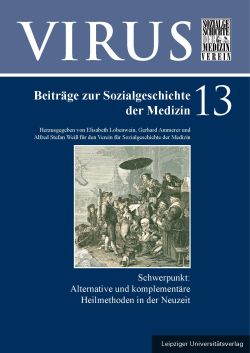
VIRUS Band 13, pp. 035-053, 2020/07/23
Schwerpunkt: Alternative und komplementäre Heilmethoden in der Neuzeit

Alternative explanations for the cause of an illness were searched frequently if the conventional methods and medicines failed in treating diseases of which the aetiology could not beestablished. Consequently, the resulting diagnosis was often determined as bedevilment or possession. It was common practice for physicians themselves to send their patients to exorcists, if their own efforts failed to effect a cure. Those exorcists then tried to banish the evil forces from the afflicted bodies by appealing to superior opposing forces. The exorcisms ofthe sick is according to the Roman Catholic Church a sacrament. The proper practices were specified through the “Rituale Romanum” from 1614.However, not all of the healers were guided by those rules. Johann Joseph Gaßner (1727–1779) fashioned his exorcisms without a single reference to the ritual guidelines of the Roman Catholic Church, and yet achieved great success with his therapies. His exorcisms can be construed as early innovative psychotherapeutic treatments when interpreting his “miraculous cures” stated in contemporary narratives. The often achieved success of the “devil banisher”, who had extraordinary suggestive and hypnotic powers, was in large parts based on the practice of a self-control therapy which could be applied afterwards by the patients in their daily life if the involuntary phenomena occurred. The lines between exorcistic doctrine and (from today’s point of view) psychotherapeutic therapy were blurred by his kind of treatment – which were unquestionably typical at that time.Fierce discussion of Gaßner’s healing methods was held during the time of a criticalanalysis of iatromechanism and traditional humoral pathology in the middle of the 1770s. However, his great success rate opposed the efforts towards public enlightenment and against superstition. Notably, they were responsible for a renewed controversial discussion on witches and the devil which was believed to have ended between the 1760s and 1770s. Therefore an alternative treatment was searched for. Such a treatment was found by the physician Franz Anton Mesmer (1734–1815) with his new developed healing method, animal magnetism, with which similar results to Gaßner could be achieved. The stellar ascent of Mesmer and his treatment can be ascribed to a direct response against Gaßner; it also had similarities to Gaßner’s therapy. Mesmer used the physical categories of matter and motion for his newly developed theses on disease and cure. He defined a concept of a global fluid as the basis for the animal magnetism. This fluid is an extremely delicate substance and can lead to a stoppage of the humours through muscle cramps. A cure could be achieved by restoring the harmony through energy transfer. Mesmer, who was also an accomplished psychologist who used methods of hypnosis and suggestion, was able to attain similar therapeutic successes as Gaßner. He was seen as the suitable alternative to Gaßner and his form of exorcism, and therefore worthy of support due to his scientific healing method which was incorporated into an enlightened concept and managed without the devil. The rapidly increasing interest – which declined just as quickly – was therefore not primarily based on animal magnetism itself. It was rather a result of the endeavours to proclaim alternative effective methods of treatment to exorcism.
Keywords: Exorcism, animal magnetism, Franz Anton Mesmer (1734–1815), Johann Joseph Gaßner (1727–1779), Rituale Romanum, miraculous cures, psychotherapy